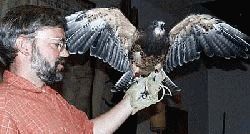Birds of Prey on the Oregon Trail
Published 12:00 am Friday, July 11, 2003

- Larry Ridenhour from the Snake River Birds of Prey National Conservation Area discussed birds that pioneers might have seen along the Oregon Trail, like the Swainson's hawk. (Baker City Herald/Kathy Orr).
By LISA BRITTON
Trending
Of the Baker City Herald
The audience members tear their gaze from the Swainson’s hawk and stare at a baby in the front row.
Larry Ridenhour quickly whips a rag from his back pocket and wipes a sticky white glob off the baby’s shirt.
Trending
andquot;That’s why you don’t get too close to the business end of a hawk,andquot; he grins.
The Oregon Trail Interpretive Center’s theater went to the birds on Wednesday when Ridenhour brought a great horned Owl, a short-eared owl and the Swainson’s hawk for his andquot;Birds of Preyandquot; presentation.
andquot;If you happened to be on the Oregon Trail 150 years ago, bouncing along, you could have seen these three birds,andquot; he said.
Ridenhour is an outdoor recreation planner at the BLM Snake River Birds of Prey National Conservation Area located south of Boise.
andquot;We have the highest concentration of nesting birds of prey than anywhere else in North America. Some would argue in the world,andquot; he said.
The three birds accompanying Ridenhour had sustained trauma or injuries that prevented re-entry into the wild.
In that case, the bird is placed with a handler who holds special state and federal permits. Without the permits, it’s illegal to own one of these protected birds of prey even picking up and keeping a fallen feather in the forest is illegal, he said.
The allure of the big birds
Center visitors crammed into the Leo Adler Theater seats for the presentation, all craning their necks for the best view of the birds perched on the stage.
Ridenhour struggles to explain why birds of prey cause such fascination.
andquot;Partly because they’re large birds. They’re not the bird hanging out in your backyard,andquot; he said.
For one thing, they don’t peck around for miniscule bugs or worms they go for the hearty meal.
andquot;These birds have a hooked beak, very sharp, very powerful talons. They’re all meat eaters and have keen vision,andquot; he said.
andquot;The beak has one purpose: to rip and tear flesh.andquot;
Hawks are diurnal hunt during the daylight hours and rely on speedy flight skills to catch prey.
andquot;They have very broad, rounded wings they use for soaring. The wind currents just pick them up,andquot; Ridenhour said.
Owls, on the other hand, have three special features for their nighttime hunts.
Unlike the vivid colors humans see during the day, owls see in shades of black, white and gray.
andquot;These guys basically have night vision,andquot; he said.
They also have asymmetrical hearing one ear canal is located high and forward, the other is lower and back.
andquot;They can actually triangulate and pinpoint the location of a sound just with their hearing,andquot; Ridenhour said.
The third owlish advantage is deadly to their prey silent flight.
Owl feathers are soft and light, unlike the stiff, noisy feathers of hawks.
andquot;They can fly and make no noise when they want to,andquot; Ridenhour said.
The great horned owl was the last to take a tour around the theater.
Ridenhour tosses his smaller leather gloves to the side and slips a welding glove onto his left hand.
Even though the three birds have been raised in captivity, they aren’t exactly affectionate.
andquot;They get used to me, they tolerate me. It’s still a thrill to go into their cages and they give me a look like ‘I could still tear your eyes out.’ And that great horned, he’s tried a few times.
andquot;Great horned owls are one of the more fierce birds you’ll find,andquot; he said.
This bird isn’t picky about diet, eating anything from porcupines to small alligators to fish and rodents.
andquot;He’ll eat pretty much anything as long as it’s smaller than he is,andquot; Ridenhour said.
Then he points to the bird’s feet.
andquot;The feet are sinister. If she were to grab my free hand and squeeze as hard as she wanted to, first her talons would go through. Even when she got to the bones, she could crush them,andquot; he said.
To learn more about birds of prey or the Snake River Conservation Area, visit the Web site at www.birdsofprey.blm.gov.
For more information about upcoming events at the Interpretive Center, call 523-1843.









